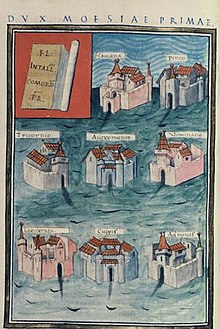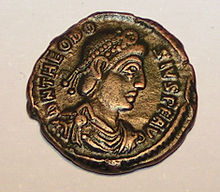Dux Moesiae primae
The Dux Moesiae primae (army leader of Moesia I) was a high officer of the Eastern Roman army and from the 4th century at the latest he was the commander ( Dux limitis ) of the Comitatenses , Limitanei and naval units stationed on the border section of the lower Danube.
His area of responsibility ( ducat ) extended to the Limes of Moesia I , Dioecesis Daciae , which corresponds to the territory in the north of today's Serbia (lowlands of Vojvodina ), Bulgaria and Romania . It was exclusively a river boundary ( ripae ), i. H. most of the forts (with the exception of bridgeheads) stood on the south bank of the Danube .
His direct superior was at the time the Notitia Dignitatum orientum (around 395) was written, the Magister militum per Illyricum .
In the hierarchy of the late Roman imperial nobility, a Dux took the position of a vir spectabilis .
Incumbents known by name:
- Theodosius (around 375)
- Camundus (470 to 472)
development
For better control of the Danube border, Emperor Aurelian and his immediate successors had five smaller provinces set up on the lower Danube instead of the previous two. The Mosia prima (capital Viminacium ) and east of it the Dacia Ripensis (capital Ratiaria ) arose in the Upper Moselle area . After this reorganization phase, in the course of the military reforms under Diocletian and Constantine I near Djerdap , the Upper Mossian Limes was divided into two surveillance sectors - upstream: pars superior ( Singidunum - Viminacium ) and downstream: pars citerior ( Iron Gate ). The office of Dux probably also existed from that time. The future emperor Theodosius was appointed Dux Moesiae superioris (later: Dux Moesiae primae ) at a young age . In 374 he was able to repel the Sarmatians who had crossed the Danube. As Emperor of the East he was forced to sign a treaty with the Goths in 382 . They were settled as federates in Thrace and Lower Moesia. This resulted in major changes for the border defense on the Mösian Danube. Due to the lack of regular troops, it had to be left to the new allies in many places. In 472 the Ostrogoth king Theodoric crossed the Danube and conquered Sirmium . Apparently the Dux Camundus met him. However, it could be that at that time he was already in the rank of Magister militum (per Illyricum). The office of Dux probably existed until the end of the 6th or beginning of the 7th century, when the province was finally overrun by the Avars and Slavs .
Administrative staff
The Officium (administrative staff) of the Dux comprised the following offices:
- Principem de eodem officio, qui completa militia adorat protector (office manager, after the end of his service as a bodyguard)
- Numerarios et adiutores eorum (Paymaster and auxiliaries)
- Commentariensem (bookkeeper and legal expert)
- Adiutorem (assistant)
- A libellis siue subscribendarium (undersecretary and entry point)
- Exceptores et ceteros officiales (clerks and other officials)
troops
The list of troops ( distributio ) des Dux was only handed down in the Notitia Dignitatum , it probably reflects the status around the years 394–395. According to the Notitia, the individual sectors of the Danube border, such as B. that of the Dux Valeriae ripensis , divided into upper ( superioris ) and subsections ( inferioris ). Epigraphic sources confirm that this was also the case in Moesia I. The soldiers of the border troops, such as those of the Legio IV Flavia in Singidunum, were no longer concentrated exclusively on their main camp, but were divided into these sections even before the Notitia was drawn up.
Distributio Numerorum
According to the ND Orientum, the following units were available to the Dux :
| Officers / unit / Limes section / forts | comment | Illustration |
|---|---|---|
| Comitatenses | ||
| Cuneus equitum Constantacorum, Pinco | A cavalry unit in the Pincum Fort (Veliko Gradište SRB). | |
| Cuneus equitum promotorum, Flaviana | ||
| Cuneus equitum sagittariorum, Tricornio | A band of mounted archers in Tricornium Fort (Ritopek SRB). | |
| Cuneus equitum Dalmatarum, Aureomonto | A group of Dalmatian horsemen stationed in the Aureus Mons fort (Seone SRB). | |
| Cuneus equitum promotorum, Viminacio | An equestrian department that was in the provincial capital Viminiacum (Stari Kostolac SRB). | |
| Cuneus equitum sagittariorum, Laedenatae | A band of mounted archers at Lederata Fort ( Ram SRB). The troops secured a Danube crossing here and the road to Viminiacum . | |
| Cuneus equitum Dalmatarum, Pinco | A group of Dalmatian horsemen in the Pincus Castle (Veliko Gradište SRB). | |
| Cuneus equitum Dalmatarum, Cuppis. | A group of Dalmatian horsemen in the Cuppae Fort (Brnjica / Golubac SRB). | |
| Auxiliares | ||
| Auxiliares reginenses, contra Reginam | A border guard unit of the auxiliary troops stationed in a bridgehead fort across from Reginum / Augusta Reginum . | |
| Auxiliares Tricornienses, Tricornio | The unit was recruited from the Moesian tribe of Tricornesii . Tricornium (Ritorpek SRB) secured the road to Ad sextum (Mali Mokri Lug SRB) and Singidunum . | |
| Auxiliares Novenses, Ad Novas | A border guard unit of the auxiliary troops stationed in the Ad Novas fort . | |
| Auxilium Margense, Margo | A border guard unit of auxiliary troops stationed in the Margum fort (Orašje, Dubravica SRB). | |
| Auxilium Cuppense, Cuppis | A border guard unit of the auxiliary troops stationed in the Cuppae Fort (Brnjica / Golubac SRB). The fort was occupied from the 1st to the 6th century AD. | |
| Auxilium Gratianense, Gratiana | A border guard unit of auxiliary troops stationed in the Fort Gratiana ( Dobra SRB). Five other units listed in the ND bear the name of Emperor Gratian (367-383). This troop, however, is likely to have been named or placed there after their location. | |
| Auxilium taliatense, Taliata | Border guard stationed in the Taliatae fort (Donji Milanovac, SRB). Their castle existed since the time of Vespasian (69-79). It should have been occupied for about 300 years. | |
| Auxilium aureomontanum, Tricornio | A unit that was originally stationed in Aureo Monte . The later garrison Tricornium was east of Viminiacum . | |
| Legiones limitanei | ||
| Praefectus legionis quartae Flaviae , Singiduno | Since the 4th century this legion was one of the stationary border troops ( Limitanei ) . A remaining troop was still stationed in their main camp under the command of a Praefectus . The Legion had been in Singidunum ( Belgrade ) since the 1st century . According to Notitia, in late antiquity their departments were scattered across several provinces of the empire. A division of this legion is mentioned on a coin that was probably minted in Gaul during the reign of the usurper Victorinus (269-271). An inscription (around 300) from Jordan refers to the construction of a road during the Tetrarchy , in which soldiers of this legion were also involved. Presumably several Gallicani units listed in the Notitia descended from the IV Legion. | |
| Praefectus legionis septimae Claudiae, Cuppis | This unit evidently descends from the Legio VII Claudia Pia Fidelis , which was stationed in the Viminacium camp for a long time . It is likely that the Septimani iuniores in the Gaul army of the Magister Equitum was a vexillation of Legio VII Claudia . But it could also be that this unit comes from the Hispanic Legio VII Gemina Felix . | |
| Praefectus mil (itum) ......, contra Margum in castris Augustoflavianensibus | The entry means: "... the prefect of the soldiers of ... in Fort Augusto Flavianensibus opposite Margum " (Orašje, Dubravica SRB); the standard name has not been passed down. | |
| Praefectus militum exploratorum, Novis | A scout unit stationed in the Novae fort ( Čezava , SRB). | |
| Praefectus militum exploratorum, Taliatae | A unit of scouts in the Taliatae fort (Veliki Gradac SRB). | |
| Praefectus militum Vincentiensium, Laedemata | A border security unit stationed in the Lederata fort ( Ram SRB). | |
| Praefectus militum exploratorum, Zmirnae | A unit of scouts. | |
| fleet | ||
| Praefectus classis Histricae, Viminacio | This unit may have emerged from the Classis Pannonica or Classis Moesica . The other naval divisions on the middle and lower Danube were under the command of the
The late antique naval departments were mostly named after their home ports or their unit. |
|
| Praefectus classis Stradensis et Germensis, Margo |
literature
- Otto Seeck : Notitia dignitatum. Accedunt notitia urbis Constantinopolitanae et laterculi provinciarum. Weidmann, Berlin 1876 ( digitized ; reprinting unchanged. Minerva, Frankfurt am Main 1962).
- J. Rodríguez González, Historia de las legiones Romanas, Madrid, 2003.
- Adrian Goldsworthy: Storia completa dellesercito romano, Modena 2007. ISBN 978-88-7940-306-1
- Yan Le Bohec: Armi e guerrieri di Roma antica. Da Diocleziano alla caduta dell'impero, Roma 2008. ISBN 978-88-430-4677-5
- Arnold Hugh Martin Jones, JR Martindale, J. Morris: The Prosopography of the Later Roman Empire: Volume 2, AD 395-527. Cambridge University Press, 1980.
- Marcel Frederik Schwarze: Roman Military History Volume 2: Study of the Roman Army and its Organization in the Sixth Century AD. BoD 2018.
- Michael DuBois: Auxillae, LuLu.Com, 2015.
- Peter Kovacs: The late roman army in Pannonia. Acta Ant. Hung. 44, 2004.
- Duncan McAndrew: The Milites hypothesis: The lost naval commands of the late Roman army. Acta Archaeologica, Volume 86, 2015. pdf
Remarks
- ^ Notitia Dignitatum, pars Secunda, in partibus Orientis XLI
- ↑ The chroniclers Zosimos (4,16,3), Jordanes Getica 282 and Ammianus Marcellinus (29,6,15 and 16 ) report on the barbarian incursions into Pannonia and Moesia and on the role of the younger Theodosius in the defense of the province of Moesia I ), Jones, Martindale, Morris 1980, p. 256, F. Schwarze 2018, p. 300.
- ↑ Officium autem habet ita: / His staff as follows:
- ↑ Notitia or .: XLI, 29
- ↑ Peter Kovacs: 2004, p. 117, ND or .: XLI, Sub dispositione viri spectabilis ducis Moesiae primae / At the disposal of the honorable general of Moesia I:
- ↑ sub dispositions
- ↑ ND or. 41, 21, DuBois 2015, p. 253
- ↑ DuBois 2015, p. 253
- ↑ DuBois 2015, p. 253
- ↑ DuBois 2015, p. 251
- ↑ DuBois 2015, p. 252
- ↑ DuBois 2015, p. 253
- ↑ DuBois 2015, p. 251
- ^ Inscription Jordan: AE 1987, 964
- ↑ ND or.XLI.33, DuBois 2015, p. 257
- ↑ DuBois 2015, p. 275
- ↑ DuBois 2015, p. 275
- ↑ DuBois 2015, p. 257







